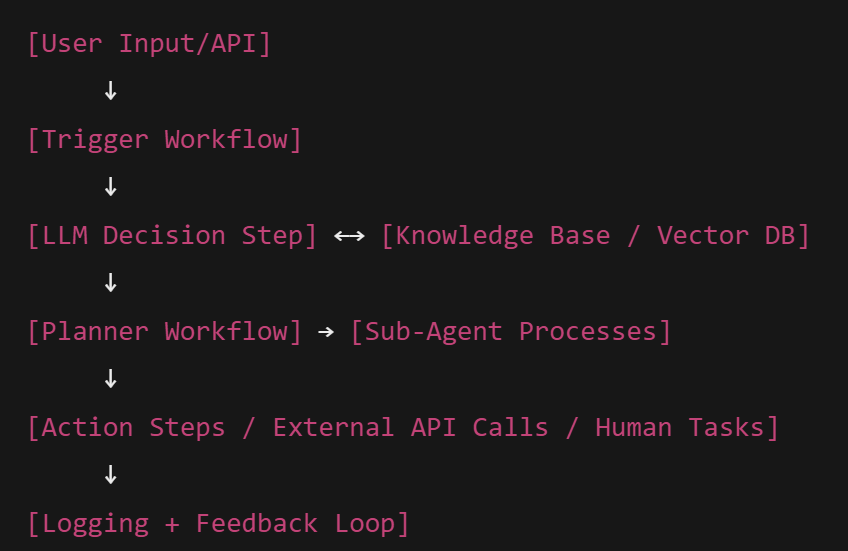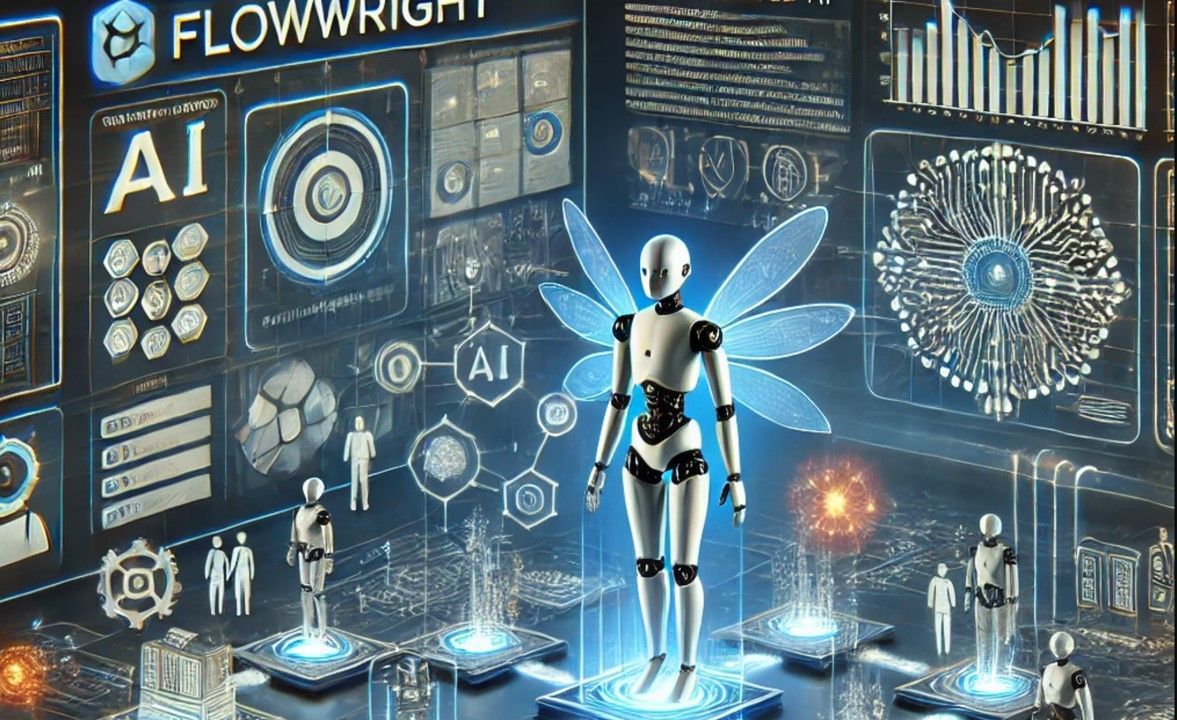Businesses are starting to explore ways to embed AI into their core operations. One emerging approach is Agentic AI—a paradigm where autonomous agents are designed to plan, reason, act, and learn independently within defined boundaries. At the intersection of this trend and enterprise-grade process automation is our enterprise workflow platform, a powerful low-code platform with robust workflow orchestration and integration capabilities.
Our team dives into how FlowWright empowers organizations to implement Agentic AI systems by leveraging its existing process engine, AI integrations, and extensible architecture to orchestrate autonomous agents that can function with intelligence and purpose.
What is Agentic AI?
Agentic AI refers to systems composed of autonomous agents capable of:
- Perceiving their environment
- Reasoning about goals and context
- Planning actions
- Executing tasks
- Learning from feedback or outcomes
Unlike traditional AI APIs that focus on narrow intelligence (e.g., image recognition, sentiment analysis), Agentic AI systems are designed to make decisions and act proactively to achieve objectives. These agents often integrate LLMs (Large Language Models), external APIs, internal knowledge bases, and task automation frameworks. Orchestrating this behavior in a scalable and manageable way requires a robust, flexible process automation platform—this is where we come in.
How FlowWright Is Ideal for Agentic AI
FlowWright provides a modular, extensible, and high-performance workflow engine with features that naturally align with the needs of autonomous agent orchestration:
- Dynamic Workflows: Build logic-driven decision trees and planning processes for agents.
- Forms and Tasks: Create interactive tasks when agents need human input.
- Process Variables: Maintain agent state, memory, and context across execution paths.
- External Integration: Easily integrate with LLMs (like GPT), vector databases, APIs, and internal data sources.
- Timers and Events: Enable scheduling, event-driven behaviors, and retries.
- Scripting and Custom Steps: Add C# scripts or custom steps to embed reasoning or actions.
- AI Plugins: Use built-in or custom AI connectors to call OpenAI, Azure AI, or local LLMs.
Architecture of an Agentic AI System with FlowWright
Here’s a simplified architecture diagram of an Agentic AI system built using FlowWright:

Our software handles each part of this process. The agent’s intelligence lives in workflows that invoke LLMs to decide, plan, and act. Our software maintains state, logs every decision, and supports looping for learning and adaptation.
Steps to Building an Agent in FlowWright
Let’s walk through building a basic autonomous agent using FlowWright.
1. Define the Agent’s Goal
For example, “Monitor a mailbox, extract customer requests, classify intent, and either auto-respond or escalate to support.”
2. Create a Triggering Mechanism
You can use a scheduled workflow or API endpoint to trigger the agent. FlowWright’s workflow REST API can receive webhook calls from inbox listeners, chatbot interfaces, or event queues.
3. Add an LLM Integration Step
Use a custom or built-in step that calls an LLM like GPT:
{
"prompt": "Classify this email: {email_body}. Return JSON with intent, urgency, and recommended action."
}
Parse the response into process variables:
intent
,
urgency
,
recommended_action
.
4. Add Decision Logic
Use FlowWright’s
Switch
or
If
steps to branch based on AI response:
- If
recommended_action= “Auto-respond” → Trigger email process - If “Escalate” → Create task for human
- If “Gather more info” → Start sub-process to query user
5. Add Learning Feedback
At the end of the process, log outcomes, update the vector DB, or fine-tune prompts. FlowWright can connect to RAG (Retrieval-Augmented Generation) pipelines to provide agents with memory and situational awareness.
Examples of Agentic AI in FlowWright
1. Autonomous Customer Support Agents
An agent monitors incoming tickets, classifies them using LLMs, searches the knowledge base using vector embeddings, responds autonomously if possible, and escalates intelligently if needed.
2. Workflow Optimizer Agent
An agent runs daily analysis on process logs, identifies bottlenecks using AI reasoning, and suggests optimizations or auto-deploys minor changes via the FlowWright API.
3. Procurement Agent
Given a goal like “source three vendors for this part,” the agent performs web/API searches, evaluates supplier data, ranks results, and creates tasks or approvals automatically.
4. RPA Controller Agent
When integrated with FlowWright’s RPA capabilities, agents can reason about what automations to invoke, retry failed bots, or schedule processes dynamically.
Enabling Multi-Agent Collaboration
FlowWright makes it easy to orchestrate multi-agent systems, where multiple agents (each a workflow) collaborate or specialize in tasks:
- Planner Agent: Determines sub-goals and delegates
- Research Agent: Performs information retrieval
- Action Agent: Executes API tasks or sends messages
- Evaluator Agent: Reviews output for accuracy
These agents can call each other’s workflows using FlowWright's process execution API, passing context and data seamlessly.
For instance:
- Planner invokes Research Agent
- Research Agent returns options
- Planner invokes Evaluator Agent
- Planner delegates final action to Action Agent
Each agent is modeled as a standalone FlowWright process that can scale horizontally, monitored and logged independently.
Integrating LLMs, Vector DBs, and RAG
FlowWright supports integrations with:
- OpenAI: for reasoning, summarization, decision-making
- Azure OpenAI: for reasoning, summarization, decision-making
- Ollama: for reasoning, summarization, decision-making
You can use steps to fetch vector results, build prompts, and embed results back into process memory variables.
Handling Autonomy and Governance
Running autonomous agents in production requires guardrails:
- Audit Trails: FlowWright logs all process and decision data
- Role-Based Access: Define which agents can perform sensitive actions
- Human-in-the-loop: Insert manual approval steps
- Execution Limits: Set loop detection, execution timeouts
- Feedback Loops: Enable agents to learn without spiraling out of control
FlowWright’s built-in engine controls, form tasks, and event monitoring offer a robust environment for responsible autonomy.
Example: Autonomous Invoice Classifier Agent
Goal: Read incoming invoices, extract data, validate vendors, and queue for payment.
Steps:
- Triggered by file drop/email
- LLM extracts: vendor name, invoice number, amount, due date
- Vendor validated via REST API to ERP
- If matched, send to payment process
- If unmatched, create task for AP clerk
- Log outcomes to audit and training data
This simple agent can replace manual triage and reduce processing time significantly.
Future Product Road Map
Our team is always as our pulse on the market, and with that comes our roadmap for Agentic AI includes:
- Native LLM Orchestration Components
- Visual Agent Debugging Tools
- Stateful Agent Memory with Vector Embeddings
- Auto-prompt builders based on process metadata
- Agent Behavior Simulation Mode
The goal is to make building and managing intelligent agents as simple as dragging steps into the designer.
Agentic AI offers immense potential to reshape how business operations are conducted—automating not just tasks, but entire decision chains. Our platform is uniquely positioned to empower this transformation by acting as the orchestration backbone for intelligent, autonomous agents. Ready to see our platform in action? Schedule a demo to explore its features and discover how it can transform your organization’s ROI using workflow automation.
See of FlowWright IDP in action. Let's customize your free proof of concept (POC).
Why FlowWright?
Platform
All Rights Reserved | Innovative Process Solutions, Inc. | Privacy Policy







